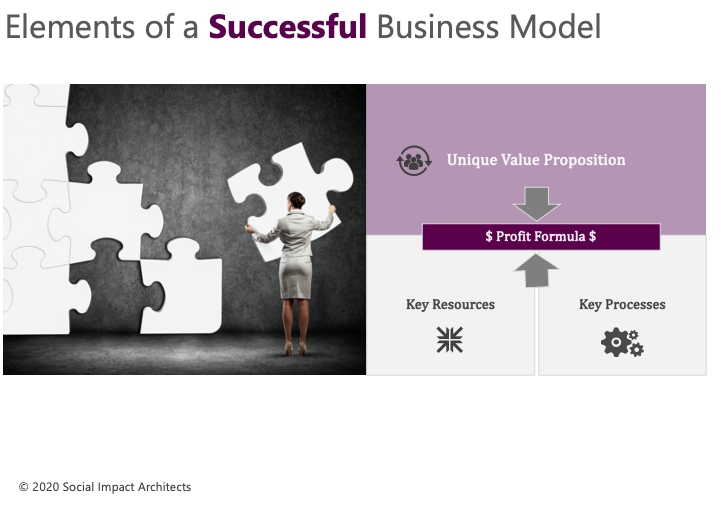 With the economic and global shifts resulting from COVID-19, everyone has had to pivot their business models. Restaurants are delivering meals rather than opening up their doors. Retailers are making it easier for clients to purchase online and pick up curbside, while educators are teaching remotely.
With the economic and global shifts resulting from COVID-19, everyone has had to pivot their business models. Restaurants are delivering meals rather than opening up their doors. Retailers are making it easier for clients to purchase online and pick up curbside, while educators are teaching remotely.
While the concept of a business model dominates for-profit companies, it is equally, if not more, important in the social sector. A business model describes how your company creates, delivers and captures value. It is not just a product or program – it is a series of intentional decisions you make to create a full experience for your clients that provides value. For for-profits, that value translates into clients paying for products or services. For nonprofits and social entrepreneurs, that value is paid for by funders and donors as well as clients (possibly).
The late American chef, Anthony Bourdain, once said, “Luck is not a business model.” This is especially true for restaurants. How many of us see a new restaurant pop up on the corner only to go out of business three months later? It isn’t just about the food served – the location, competition, client service and many other factors also decide the fate of that restaurant. The same is true for nonprofits – a business model is about more than just your program. The entire experience of your clients and donors is what makes your organization successful.
To make business models more accessible, we have created a recipe that breaks down business models into their key ingredients and steps and applies them to the social sector.
The Basics of a Social Business Model
First, determine your unique value proposition – what makes you special? Some key questions to consider:
- Who are your target clients?
- What client “need” or problem are you fulfilling or solving?
- What are you offering that will fulfill that need or solve that problem?
- Why is this solution more attractive than the clients’ current solution?
- How do you sell your offering in a way that meets the needs of your client?
- How will you document the client value you provide?
- How will you continue to meet the changing needs of your clients and the market?
Second, blend your unique value proposition with key resources and processes. Key resources are the most important resources needed to profitably or efficiently deliver the client value proposition. Examples of key resources include brand, people, partners, facilities and equipment, or technology. Key processes combined with key resources ensure profitable or efficient delivery to clients. The key is to find ways to deliver value that are repeatable and scalable. Examples of key processes include culture and values (e.g., Southwest Airlines), client service (e.g., Nordstrom), design (e.g., Target), sales (e.g., Mary Kay) or talent (e.g., Teach for America).
By striking the right balance between the unique value proposition, key resources and key processes, you can build an airtight business model. The right combination makes your exact business model difficult to imitate, because it is uniquely yours.
Impact Business Models for Nonprofits and Social Enterprises
For social entrepreneurs, we have developed an “impact business model” (also called a social enterprise), which is a unique construct that generates profit (or breakeven) for its owners, creates positive change and navigates the optimal tension between the two for the success of the model. Even though many enterprises start with a hypothesis on their business model, those hypotheses are in constant flux. In 2009, Duke did a study on social entrepreneurs and 100% reported making significant changes to their business model – from products and services to marketing plans and pricing strategy.
Nonprofits primarily use one of these three approaches:
- Embedded
- The enterprise and the social program are one and the same.
- The business is created to serve the clients (central to the mission).
- Integrated
- The business activities overlap with the social programs.
- The business is created as a funding mechanism and to expand/enhance the mission.
- External
- The business and mission are separate and may not relate to the mission.
- The business is created mainly as a funding mechanism.
There are many impact business models that nonprofits use, but the most common are: employment (see REDF for more details), market intermediary (e.g., Fair Trade), fee-for-service (e.g., art museums), low-income client (e.g., sliding scale) and service subsidization (e.g., event rental).
For-profits primarily use one of these three approaches:
- Corporate Philanthropy
- The enterprise maximizes profit and gives back to the community through donations and marketing efforts.
- Strategic Corporate Social Responsibility
- The enterprise is a given, but the business wants to leverage its assets to be a good global citizen.
- Strategic CSR is more than just PR and can look at ways to leverage assets (e.g., value chain, employment, talent) for benefit of community.
- Integrated Business Model
- The business activities overlap with the social elements.
- The business and the mission are interconnected and are driven by culture-based ethos around all aspects of business operations.
There are also many impact business models that for-profits use, but the most common are: buy one, give one (e.g., Warby Parker), bottom of the pyramid (e.g., microfinance), shared ownership (e.g., King Arthur’s Flour), and two-sided marketplace (e.g., Kickstarter).
With this recipe, you have an intentional process for deciding how you plan to pivot your business model in 2020 to be more relevant and meaningful to your clients and donors. With any luck, you will also find a winning combination that allows for even greater success in 2021. If you have already “pivoted,” please share with our fellow Social TrendSpotters how you have adjusted your business model to better serve clients.

